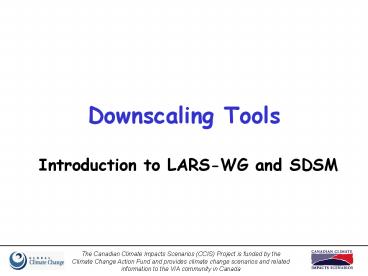Downscaling Tools - PowerPoint PPT Presentation
1 / 27
Title:
Downscaling Tools
Description:
The Canadian Climate Impacts Scenarios (CCIS) Project is funded by the Climate ... INRS-ETE : Andr St Hilaire, Bernard Bob e, Taha Ouarda - UQAM : Peter Zwack ... – PowerPoint PPT presentation
Number of Views:419
Avg rating:3.0/5.0
Title: Downscaling Tools
1
Downscaling Tools
- Introduction to LARS-WG and SDSM
2
LARS-WG stochastic weather generator (
http\\www.iacr.bbsrc.ac.uk\mas-models\larswg.html
)
- Generation of long weather time-series suitable
for risk assessment - Ability to extend the simulation of weather to
unobserved locations - A computationally inexpensive tool to produce
climate change scenarios incorporating changes in
means and in variability
3
LARS-WG stochastic weather generator(
http\\www.lars.bbsrc.ac.uk\model\larswg.html )
- Generates precipitation, min and max temperature
and solar radiation - Modelling of precipitation events is based on
wet/dry series - Semi-empirical distributions are used for
precipitation amounts, dry/wet series and solar
radiation - Temperature and solar radiation are conditioned
on the wet/dry status of a day - Temperature and solar radiation are
cross-correlated
4
LARS-WG
- Model calibration - SITE ANALYSIS
- Model validation - QTEST
- Generation of synthetic weather data - GENERATOR
5
SITE ANALYSIS
6
QTEST
Compare observed and synthetic data to evaluate
LARS-WG performance
7
GENERATOR
Generate synthetic weather data to extend time
series, or for climate change studies
8
GENERATOR
9
Limitations of LARS-WG (and weather generators in
general) ...
- Temporal downscaling only
- Designed for use at individual sites only (no
spatial correlation) - Can only represent events in calibration data set
- Generally underestimate variability
10
SDSM
- A decision support tool for assessing local
climate change impacts - Facilitates the rapid development of multiple,
low-cost, single-site scenarios of daily surface
weather variables under current and future
climate forcing - Based on a multiple regression-based method
11
SDSM Structure
- 7 steps
- Quality Control and Data Transformation
- Screening of Predictor Variables
- Model Calibration
- Weather Generation (using observed predictors)
- Statistical Analyses
- Graphing Model Output
- Scenario Generation (using climate model
predictors)
12
(No Transcript)
13
(No Transcript)
14
(No Transcript)
15
Model Verification
16
(No Transcript)
17
(No Transcript)
18
(No Transcript)
19
(No Transcript)
20
Tmax gt 25C
21
(No Transcript)
22
Cautionary Remarks
- SDSM provides a parsimonious technique of
scenario construction that complements other
methods - SDSM should not be used uncritically as a black
box (evaluate all relationships using
independent data) - Local knowledge is an invaluable source of
information when determining sensible
combinations of predictors - Daily precipitation amount at individual stations
is the most problematic variable to downscale - The plausibility of all SDSM scenarios depends on
the realism of the climate model forcing - Try to apply multiple forcing scenarios (via
different GCMs, ensemble members, timeslices,
emission pathways, etc.)
23
Projet FACC (en cours 2003-2004)Etude sur
force/faiblesse de SDSM et LARS-WGpour extrêmes
et variabilité climatique
Coordonnateur Philippe Gachon Collaborateurs
- Ouranos Alain Bourque, René Roy, Claude
Desjarlais, Georges Desrochers, Vicky Slonosky,
Diane Chaumont - EC-SMC (Qc) Jeanna Goldstein,
Jennifer Milton, Nicolas Major - McGill VTV
Nguyen, Charles Lin - INRS-ETE André St
Hilaire, Bernard Bobée, Taha Ouarda - UQAM
Peter Zwack - CCIS Elaine Barrow - Post-Doc et
étudiants Tan Nguyen (PostDoc) Massoud Hessami
(PostDoc) Mohamed Abul Kashem (PhD)
24
1st Objective intercompare SDSM LARS-WG for
downscaling extremes (regional case-studies)
5 Régions à étudier (Stat. Downscaling)
1961-1990 Tmin Tmax Tmoy Precipitation tot.
2
1
4
3
5
25
(No Transcript)
26
2nd Objective Develop observed climate indices
used for verification analysis (using STARDEX
software)
27
THANK YOU FOR YOUR ATTENTION !!






























